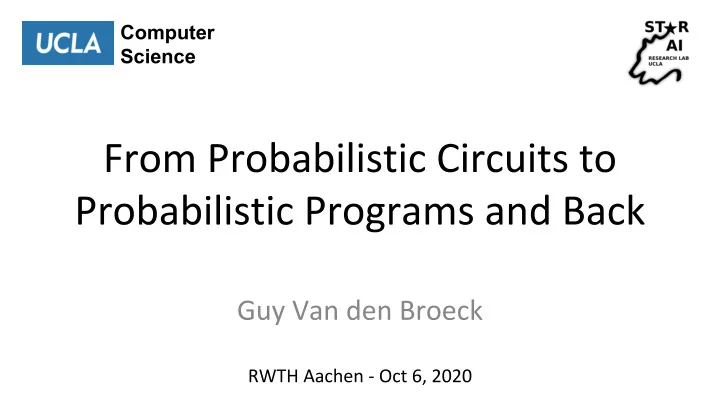

Computer Science
Let me be provocative Probabilistic graphical models is how we do probabilistic AI! Graphical models of variable-level (in)dependence are a broken abstraction. [VdB KRR15]
Let me be provocative Probabilistic graphical models is how we do probabilistic AI! Graphical models of variable-level (in)dependence are a broken abstraction. ∧ ⇒ [VdB KRR15]
Let me be provocative Probabilistic graphical models is how we do probabilistic AI! Graphical models of variable-level (in)dependence are a broken abstraction. Bean Machine [ PGM20]
Let me be provocative We may have gotten stuck in a local optimum The choice of representing a distribution primarily by its variable-level (in)dependencies is a little arbitrary… What if we made some different choices?
Computational Abstractions Let us think of probability distributions as objects that are computed. Abstraction = Structure of Computation ‘closer to the metal’ Two examples: 1. Probabilistic Circuits 2. Probabilistic Programs
Probabilistic Circuits
Tractable Probabilistic Models " Every talk needs a joke and a literature overview slide, not necessarily distinct " - after Ron Graham
Input nodes c are tractable (simple) distributions, e.g., univariate gaussian or indicator p c (X=1) = [X=1]
[ ]
How expressive are probabilistic circuits? density estimation benchmarks dataset best circuit BN MADE VAE dataset best circuit BN MADE VAE nltcs -5.99 -6.02 -6.04 -5.99 dna -79.88 -80.65 -82.77 -94.56 msnbc -6.04 -6.04 -6.06 -6.09 kosarek -10.52 -10.83 - -10.64 kdd -2.12 -2.19 -2.07 -2.12 msweb -9.62 -9.70 -9.59 -9.73 plants -11.84 -12.65 -12.32 -12.34 book -33.82 -36.41 -33.95 -33.19 audio -39.39 -40.50 -38.95 -38.67 movie -50.34 -54.37 -48.7 -47.43 jester -51.29 -51.07 -52.23 -51.54 webkb -149.20 -157.43 -149.59 -146.9 netflix -55.71 -57.02 -55.16 -54.73 cr52 -81.87 -87.56 -82.80 -81.33 accidents -26.89 -26.32 -26.42 -29.11 c20ng -151.02 -158.95 -153.18 -146.9 retail -10.72 -10.87 -10.81 -10.83 bbc -229.21 -257.86 -242.40 -240.94 pumbs* -22.15 -21.72 -22.3 -25.16 ad -14.00 -18.35 -13.65 -18.81
Want to learn more? Tutorial (3h) Overview Paper (80p) https://youtu.be/2RAG5-L9R70 http://starai.cs.ucla.edu/papers/ProbCirc20.pdf
Training PCs in Julia with Juice.jl Training maximum likelihood parameters of probabilistic circuits julia> using ProbabilisticCircuits; julia> data, structure = load(...); julia> num_examples(data) 17412 julia> num_edges(structure) 270448 julia> @btime estimate_parameters(structure , data); 63 ms Custom SIMD and CUDA kernels to parallelize over layers and training examples. [ https://github.com/Juice-jl/]
Probabilistic circuits seem awfully general. Are all tractable probabilistic models probabilistic circuits?
[ ]
[ ]
The AI Dilemma Pure Learning Pure Logic
The AI Dilemma Pure Learning Pure Logic • Slow thinking: deliberative, cognitive, model-based, extrapolation • Amazing achievements until this day • “ Pure logic is brittle ” noise, uncertainty, incomplete knowledge, …
The AI Dilemma Pure Learning Pure Logic • Fast thinking: instinctive, perceptive, model-free, interpolation • Amazing achievements recently • “ Pure learning is brittle ” bias, algorithmic fairness, interpretability, explainability, adversarial attacks, unknown unknowns, calibration, verification, missing features, missing labels, data efficiency, shift in distribution, general robustness and safety fails to incorporate a sensible model of the world
Pure Logic Probabilistic World Models Pure Learning A New Synthesis of Learning and Reasoning • “ Pure learning is brittle ” bias, algorithmic fairness , interpretability, explainability , adversarial attacks, unknown unknowns, calibration, verification, missing features , missing labels, data efficiency, shift in distribution, general robustness and safety fails to incorporate a sensible model of the world
Prediction with Missing Features X 1 X 2 X 3 X 4 X 5 Y Classifier Train x 1 Predict x 2 X 1 X 2 X 3 X 4 X 5 x 3 x 1 x 4 x 2 ? x 5 x 3 ? x 6 x 4 x 7 ? x 5 x 8 x 6 Test with missing features
Expected Predictions Consider all possible complete inputs and reason about the expected behavior of the classifier Experiment: f(x) = ● logistic regres. p(x) = ● naive Bayes [ ]
What about complex feature distributions? ● feature distribution is a compatible probabilistic circuits ● classifier is a regression circuit Recursion that “breaks down” the computation. Expectation of function m w.r.t. dist. n ? Solve subproblems: (1,3), (1,4), (2,3), (2,4) [ ]
Experiments with Probabilistic Circuits [ ]
Model-Based Algorithmic Fairness: FairPC Learn classifier given ● features S and X ● training labels D Group fairness by demographic parity: Fair decision Df should be independent of the sensitive attribute S Discover the latent fair decision Df by learning a PC. [ ]
Probabilistic Sufficient Explanations Goal: explain an instance of classification (a specific prediction) Explanation is a subset of features, s.t. 1. The explanation is “probabilistically sufficient” Under the feature distribution, given the explanation, the classifier is likely to make the observed prediction. 2. It is minimal and “simple” [ ]
Pure Logic Probabilistic World Models Pure Learning A New Synthesis of Learning and Reasoning “ Pure learning is brittle ” bias, algorithmic fairness , interpretability, explainability , adversarial attacks, unknown unknowns, calibration, verification, missing features , missing labels, data efficiency, shift in distribution, general robustness and safety We need to incorporate a sensible probabilistic model of the world
Probabilistic Programs
, …
Dice probabilistic programming language http://dicelang.cs.ucla.edu/ https://github.com/SHoltzen/dice [ ]
• • • • •
• •
…
• • ≈ • • •
Factorized Inference in Dice Network Verification
First-Class Observations Frequency Analyzer for a Caesar cipher in Dice
import PL.* - • • • • • •
1. 2. 3. 4.
Compiler Optimizations (sneak preview) Inference time in milliseconds
● ● ● Programming Languages Artificial Intelligence S y m Weighted Model Counting b o l i c E x e c u t i o n Abstract Symbolic Compilation Interpretation Bayesian Networks Predicate Abstraction Probabilistic Model Checking Independence Predicate Abstraction Lifted Inference Weakest Precondition Knowledge Compilation
Thanks
Recommend
More recommend